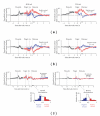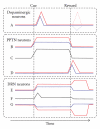A neural correlate of predicted and actual reward-value information in monkey pedunculopontine tegmental and dorsal raphe nucleus during saccade tasks
- PMID: 22013541
- PMCID: PMC3195531
- DOI: 10.1155/2011/579840
A neural correlate of predicted and actual reward-value information in monkey pedunculopontine tegmental and dorsal raphe nucleus during saccade tasks
Abstract
Dopamine, acetylcholine, and serotonin, the main modulators of the central nervous system, have been proposed to play important roles in the execution of movement, control of several forms of attentional behavior, and reinforcement learning. While the response pattern of midbrain dopaminergic neurons and its specific role in reinforcement learning have been revealed, the role of the other neuromodulators remains rather elusive. Here, we review our recent studies using extracellular recording from neurons in the pedunculopontine tegmental nucleus, where many cholinergic neurons exist, and the dorsal raphe nucleus, where many serotonergic neurons exist, while monkeys performed eye movement tasks to obtain different reward values. The firing patterns of these neurons are often tonic throughout the task period, while dopaminergic neurons exhibited a phasic activity pattern to the task event. The different modulation patterns, together with the activity of dopaminergic neurons, reveal dynamic information processing between these different neuromodulator systems.
Figures










Similar articles
-
Reward prediction-related increases and decreases in tonic neuronal activity of the pedunculopontine tegmental nucleus.Front Integr Neurosci. 2013 May 14;7:36. doi: 10.3389/fnint.2013.00036. eCollection 2013. Front Integr Neurosci. 2013. PMID: 23717270 Free PMC article.
-
[Reward processing of the basal ganglia--reward function of pedunculopontine tegmental nucleus].Brain Nerve. 2009 Apr;61(4):397-404. Brain Nerve. 2009. PMID: 19378809 Review. Japanese.
-
Fixational saccade-related activity of pedunculopontine tegmental nucleus neurons in behaving monkeys.Eur J Neurosci. 2014 Aug;40(4):2641-51. doi: 10.1111/ejn.12632. Epub 2014 May 27. Eur J Neurosci. 2014. PMID: 24863483
-
Reward prediction error computation in the pedunculopontine tegmental nucleus neurons.Ann N Y Acad Sci. 2007 May;1104:310-23. doi: 10.1196/annals.1390.003. Epub 2007 Mar 7. Ann N Y Acad Sci. 2007. PMID: 17344541 Review.
-
Activation of Pedunculopontine Glutamate Neurons Is Reinforcing.J Neurosci. 2017 Jan 4;37(1):38-46. doi: 10.1523/JNEUROSCI.3082-16.2016. J Neurosci. 2017. PMID: 28053028 Free PMC article.
Cited by
-
Neuromodulation of thought: flexibilities and vulnerabilities in prefrontal cortical network synapses.Neuron. 2012 Oct 4;76(1):223-39. doi: 10.1016/j.neuron.2012.08.038. Neuron. 2012. PMID: 23040817 Free PMC article. Review.
-
Local Field Potentials Reflect Dopaminergic and Non-Dopaminergic Activities within the Primate Midbrain.Neuroscience. 2019 Feb 10;399:167-183. doi: 10.1016/j.neuroscience.2018.12.016. Epub 2018 Dec 19. Neuroscience. 2019. PMID: 30578975 Free PMC article.
-
Activity in mouse pedunculopontine tegmental nucleus reflects action and outcome in a decision-making task.J Neurophysiol. 2013 Dec;110(12):2817-29. doi: 10.1152/jn.00464.2013. Epub 2013 Oct 2. J Neurophysiol. 2013. PMID: 24089397 Free PMC article.
-
A comparison of the subsecond dynamics of neurotransmission of dopamine and serotonin.ACS Chem Neurosci. 2013 May 15;4(5):704-14. doi: 10.1021/cn4000605. Epub 2013 Apr 29. ACS Chem Neurosci. 2013. PMID: 23627553 Free PMC article. Review.
-
Serotonin and aversive Pavlovian control of instrumental behavior in humans.J Neurosci. 2013 Nov 27;33(48):18932-9. doi: 10.1523/JNEUROSCI.2749-13.2013. J Neurosci. 2013. PMID: 24285898 Free PMC article.
References
-
- Waelti P, Dickinson A, Schultz W. Dopamine responses comply with basic assumptions of formal learning theory. Nature. 2001;412(6842):43–48. - PubMed
-
- Richmond BJ, Liu Z, Shidara M. Neuroscience. Predicting future rewards. Science. 2003;301(5630):179–180. - PubMed
-
- Samejima K, Ueda Y, Doya K, Kimura M. Representation of action-specific reward values in the striatum. Science. 2005;310(5752):1337–1340. - PubMed
-
- Graybiel AM. The basal ganglia: learning new tricks and loving it. Current Opinion in Neurobiology. 2005;15(6):638–644. - PubMed
Publication types
MeSH terms
LinkOut - more resources
Full Text Sources

